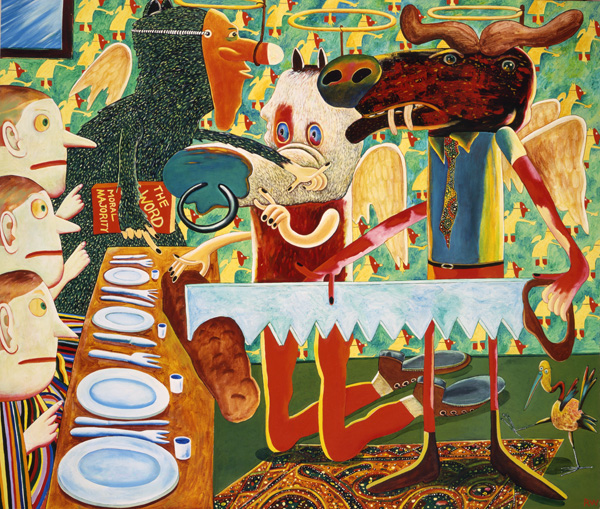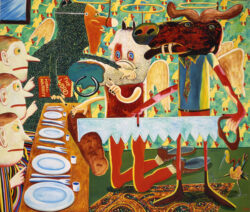Robert Joseph Warrens
For four decades artist Robert Joseph Warrens has used his painting to explore the nature of art, social ills, and the polluting of the environment.

Courtesy of Sylvia Schmidt
The Moral Majority Breaking Bread. Warrens, Robert (artist)
For four decades, Louisiana artist Robert Joseph Warrens has used his art to examine social ills, environmental pollution, and the very nature of art. His works have railed against reactionary politicians and the religious right—featuring caricatures of David Duke and Jerry Falwell—and against degradation of the natural world, such as his BP Oil Spill Series, condemning the Deepwater Horizon oil spill in the Gulf of Mexico in 2010. Ironically, his environmental series The Pond was on exhibit in New Orleans in August 2005 when Hurricane Katrina hit and floodwalls collapsed, inundating the city. Responding to Katrina, Warrens produced perhaps his most dramatic work yet, a series of paintings titled Wading In Water: The Katrina Series.
Warrens, who has resided in Mandeville, Louisiana, since Hurricane Katrina, uses a complex and satirical pictorial vocabulary in his works that is disarming, engaging, entertaining, and often enigmatic. His intensely bright and colorful cartoon-like imagery are a playful means to express dark messages. He often uses frogs, rabbits, and other animals as allegorical elements to help explain social conditions. Most of his paintings are, to some degree, autobiographical. They are statements of anger, loss, and anxiety reflecting experienced events, but nothing is what it seems to be at first glance.
“The hurricane gave me all these reasons to create these apocalyptic and wonderful skies,” he said, adding, “Sunsets are always so beautiful here because of pollution and not just the coming of a storm.” In a 2004 radio interview with New Orleans artist Jacqueline Bishop, Warrens talked about his conflicting fascination with air pollution emitted from the chemical corridor between New Orleans and Baton Rouge, and the region’s extravagantly melodramatic sunsets. “I guess it’s a strange occurrence that pollution can create such beauty and we appreciate the beauty and ignore what’s actually happening.”
Born in Sheboygan, Wisconsin, in 1933, Warrens received a bachelor of science degree from the University of Wisconsin in Milwaukee, and later an MFA from the University of Iowa in Iowa City. In 1959, he took a teaching position at Concord College in Athens, West Virginia. In 1967, he moved south to teach art at Louisiana State University in Baton Rouge, where he retired in 1998 as a professor emeritus. “In the 1960s, I thought culture was imploding,” Warrens said in the 2004 radio interview. “Moving from West Virginia to Louisiana was a real cultural shock. Louisiana was just mind-blowing in itself. You had the assassinations of JFK, Bobby Kennedy, Martin Luther King, the Vietnam War, sexual revolution, the drug culture, student demonstrations, race riots—all this stuff occurring at once and I thought I needed to revaluate what I’m doing. I’ve got to find an art that expresses the time period. So I tried to be as outrageous as the time itself.”
To do so, Warrens looked to emerging art movements in Chicago, Illinois, and California, where young artists were turning their backs on the abstract expressionists who had dominated the New York art world. Warrens took notice of the Chicago Imagists, especially the Hairy Who, a group of avant-garde artists influenced by outsider artists and art created by the clinically insane. “The freedoms of what they were doing back then was so enticing that I just had to become part of that mindset,” he said. “That allowed a lot of artists to feel certain freedoms to create their idiosyncratic art and kind of imagery.” In New Orleans, he became part of a group a New Orleans art critic dubbed the Visionary Imagists.
To describe Warrens and his work, art critics have searched for words and phrases such as “Louisiana fabulist,” “maestro,” “a primary source, like an oil well, a gold mine, a sweet water well,” “a lover of paint,” “a painter’s painter . . . with a usual blend of Van Gogh and Stephen King,” “ferocious with a dash of humor,” “hallucinogenic,” “funky and outrageous,” and “the interpreter of the ridiculous and absurd that dwell among the commonplace and superfluous.” Prominent British art critic Edward Lucie-Smith, writing in his book Art in the Eighties (1990), described Warrens’s “fantasy” paintings as the “quintessence of this particular aspect of Louisiana art.”
Fantasy seems fitting to describe Warrens and his paintings. As an artist, he considers himself an entertainer, an actor upon a stage where he can create illusions and fantasies before viewers’ eyes. “I can perform different roles, assume different costumes,” he said in 2007. “That’s why I feel comfortable shifting from one subject to another. I can’t imagine staying with any one thing any length of time.”
Warrens has received an impressive list of honors, including a grant from the Pollack-Krasner Foundation, two fellowships from the National Endowment for the Arts, and awards from the Joan Mitchell Foundation and the Andy Warhol Foundation for the Visual Arts. In 1990, the New Orleans Museum of Art exhibited a twenty-year retrospective of Warrens’s work in Paintspitter: Paintings and Constructions by Robert Warrens. In 2007, the Ogden Museum of Southern Art in New Orleans featured his Katrina series as part of the museum’s ongoing Southern Masters Series exhibitions. His paintings have been featured in single and group shows at the Whitney Museum of Art in New York, the Chicago Art Institute, and the Corcoran Gallery of Art in Washington, D.C.
Warrens’s work can be found in numerous private, corporate, and public collections, including the Arts Council of Greater New Orleans; Arts and Humanities Council of Baton Rouge, Louisiana; the Aquarium of the Americas in New Orleans; Baton Rouge Centroplex Governmental Building; the Birmingham Museum of Art in Birmingham, Alabama; the High Museum of Art in Atlanta, Georgia; the Besthoff Collection in New Orleans; Louisiana State University Museum in Baton Rouge; the New Orleans Museum of Art; the Ogden Museum of Southern Art in New Orleans; St. Mary’s College of Maryland Gallery in St. Mary’s City, Maryland; Tulane University in New Orleans; Southeastern Louisiana University in Hammond; and the Frederick R. Weisman Art Foundation in Los Angeles, California.
